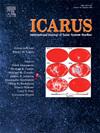A highly resonant Neptunian region: A systematic search for two-body and three-body mean-motion resonances
IF 2.5
2区 物理与天体物理
Q2 ASTRONOMY & ASTROPHYSICS
引用次数: 0
Abstract
In this study, a large-scale numerical investigation of resonant objects in the Neptune region is presented, focusing on both two-body and three-body mean-motion resonances (MMRs). Two separate simulations were conducted to identify resonant populations and quantify their prevalence.
In Simulation 1, two-body MMRs with Uranus and Neptune up to the resonant order , as well as three-body MMRs involving both planets up to the order , were examined. Using automated resonance classification techniques, it was found that 42.1% of objects are resonant, increasing to 58.2% when including controversial cases. This is significantly higher than the resonant fraction observed in the main asteroid belt. The results confirm that two-body MMRs with Neptune dominate, with a smaller but significant fraction of three-body resonances and two-body resonances with Uranus.
In Simulation 2, the analysis was extended to higher-order () and high-integer-coefficient () two-body resonances with Neptune, testing whether previously classified non-resonant objects might belong to higher-order MMRs. This second simulation revealed an additional 108 resonances and 104 new confirmed resonant objects, bringing the total fraction of resonant asteroids in the region to 49.3% confirmed cases and 65.1% with controversial cases included. Many new two-body MMRs with Neptune are found. Notably, some objects were found to be trapped in multiple resonances simultaneously.
These results demonstrate that MMRs play an important role in shaping the trans-Neptunian region, with an overall resonance fraction more than three times higher than in the main asteroid belt. All objects in this region may be in fact resonant.
一个高度共振的海王星区域:对二体和三体平均运动共振的系统搜索
在这项研究中,对海王星区域的共振物体进行了大规模的数值研究,重点研究了两体和三体平均运动共振(MMRs)。进行了两次单独的模拟,以确定共振种群并量化其流行程度。在模拟1中,研究了天王星和海王星共振阶数为q≤10的两体mmr,以及两行星共振阶数为q≤6的三体mmr。使用自动共振分类技术,发现42.1%的物体是共振的,当包括有争议的情况时,增加到58.2%。这明显高于在主小行星带观测到的共振分数。结果证实,与海王星的两体mmr占主导地位,与天王星的三体共振和两体共振的比例较小但很重要。在模拟2中,将分析扩展到与海王星的高阶(q≤20)和高整数系数(mi≤50)两体共振,测试先前分类的非共振物体是否可能属于高阶mmr。第二次模拟发现了额外的108个共振和104个新确认的共振天体,使该地区共振小行星的总比例达到49.3%,包括有争议的天体的总比例为65.1%。发现了许多新的海王星双体mmr。值得注意的是,一些物体被发现同时被困在多个共振中。这些结果表明,mmr在形成海王星外区域方面发挥了重要作用,其总共振分数比主小行星带高3倍以上。事实上,这个区域内的所有物体都可能发生共振。
本文章由计算机程序翻译,如有差异,请以英文原文为准。
求助全文
约1分钟内获得全文
求助全文
来源期刊

Icarus
地学天文-天文与天体物理
CiteScore
6.30
自引率
18.80%
发文量
356
审稿时长
2-4 weeks
期刊介绍:
Icarus is devoted to the publication of original contributions in the field of Solar System studies. Manuscripts reporting the results of new research - observational, experimental, or theoretical - concerning the astronomy, geology, meteorology, physics, chemistry, biology, and other scientific aspects of our Solar System or extrasolar systems are welcome. The journal generally does not publish papers devoted exclusively to the Sun, the Earth, celestial mechanics, meteoritics, or astrophysics. Icarus does not publish papers that provide "improved" versions of Bode''s law, or other numerical relations, without a sound physical basis. Icarus does not publish meeting announcements or general notices. Reviews, historical papers, and manuscripts describing spacecraft instrumentation may be considered, but only with prior approval of the editor. An entire issue of the journal is occasionally devoted to a single subject, usually arising from a conference on the same topic. The language of publication is English. American or British usage is accepted, but not a mixture of these.
 求助内容:
求助内容: 应助结果提醒方式:
应助结果提醒方式:


